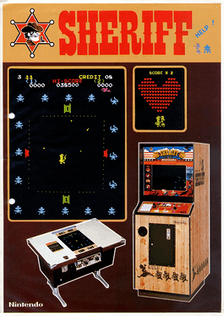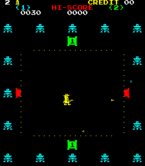Sheriff (video game)
| Sheriff | |
|---|---|
 Arcade flyer of Sheriff | |
| Developer(s) | Nintendo R&D1 |
| Publisher(s) |
Nintendo (Japan, Europe) Exidy (North America) |
| Designer(s) | Genyo Takeda[1] |
| Artist(s) | Shigeru Miyamoto |
| Platform(s) | Arcade |
| Release | |
| Genre(s) | Multi-directional shooter |
| Mode(s) |
Single-player, Two-player[5] |
| Cabinet | Up-right, Cocktail |
| Arcade system | Nintendo 8080[6] |
| CPU |
8080 @ 2.016 MHz, 8035 @ 400 kHz[2] |
| Sound |
SN76477 @ 400 kHz, DAC @ 400 kHz,[2] Mono[5] |
| Display |
Raster (vertical), 224×256 resolution, 8 out of 1024 colors[6] |
Sheriff (Japanese: シェリフ), also known as Bandido, is a 1979 arcade game by Nintendo. It is one of a group of Western-themed video games from the 1970s, preceded by at least Western Gun, Outlaw, and Boot Hill. The player controls a county sheriff tasked with defense of a town against bandits, to rescue the captured woman.
Gameplay

The game's concept is Nintendo's first damsel in distress theme, predating Donkey Kong (1981). The player controls a sheriff character against a gang of attacking bandits, to defend the town and rescue the captured woman.[7][8]
Sheriff distinctly features independent dual-joystick controls, which is a configuration unusual for arcade games and nonexistent in consoles at the time. One joystick moves the character and one aims and fires, each in eight separate directions, allowing the sheriff to walk in one direction while shooting in another.[8] The movement joystick is set with a considerable time delay before moving.
16 bandits surround the outer rim, marked by a dotted barricade. Bullets from either the sheriff or the bandits can destroy these barriers, and they can function as defensive walls or aiming obstacles for the player. Unbreakable bricks also exist on the midpoint of each side of the screen, and display the current level number.
The basic action taken by the enemy bandits is to walk around the outer rim while firing bullets at the sheriff, but they will sometimes enter into the central area, along with a change in game music. The sheriff must avoid touching the bandits, dodge bullets, and shoot all 16 bandits to complete each level.
Development
The game was developed by Nintendo R&D1 in 1979, designed by Genyo Takeda with art by Shigeru Miyamoto.[1] Some sources[9][10][11] assert that Ikegami Tsushinki also did design work on Sheriff.
Release
The game was originally released in two formats: an upright cabinet and a cocktail (tabletop) version. These versions were imported to Europe and Asia. In the UK, Sheriff was licensed for production and distribution by Bell-Fruit Manufacturing in an upright cabinet. Bell-Fruit's core product range at the time was fruit/slot machines. Sheriff (and later Puckman) marked the company's first, and short lived, diversification into the market of video games as licensee, so the cabinet design for this territory differs considerably from that of the Japanese version. Although it features the same marquee and bezel design, it shares many properties more commonly associated with slot machines, such as a lack of side art or cabinet decals. However, the game's title in this region remains unchanged as Sheriff.
Sequels
Many players were unable to cope with the 8-way joystick of the original game, leading to its relative unpopularity. The sequel, Sheriff 2 was released in 1979, and was also distributed by Exidy in 1980 and released as Bandido. It features the addition of color graphics, minor changes in bonus scoring, characters being changed to cute animals, and a simplified control system. The 8-way joystick used for shooting was replaced with a normal button, so the sheriff can only shoot in the direction he is facing. Another game pattern was added, where the bandits enter into the central area, but run straight through the top half instead of chasing the sheriff. The player can gain bonus points if he manages to shoot all of the bandits while they are running through the central area. However, Sheriff 2 was not distributed widely enough to gain any sort of following.
Reception
1up said of this early effort, "Sheriff put Nintendo on the right track as a game developer.".[8]
Legacy
More than two decades after the two arcade releases, it was rereleased as part of WarioWare, Inc.: Mega Microgame$!, released for the Game Boy Advance in 2003.[8] In WarioWare, Sheriff was included as both a microgame and as a minigame ("Wario's Sheriff") in which Wario takes the role of the sheriff. Standard controls apply to the microgame version, but in the minigame version, the L/R buttons can make the sheriff face in the opposite direction without moving. The time delay for moving the sheriff was removed, and the sheriff's walking speed is greatly increased from the original. When the player's points double after completing a certain amount of levels, the sheriff also gains extra lives, reducing the game's difficulty considerably.
The Sheriff character has appeared in the Super Smash Bros. series starting with Super Smash Bros Melee, in which he appears as one of the many collectible Trophies in the game. Sheriff later returned in Super Smash Bros. for Nintendo 3DS and Wii U as an assist trophy where he fires a succession of 8 bullets in a random order on the battlefield when summoned.
References
- 1 2 "Iwata Asks: Punch-Out!! - Investigating a Glove Interface". Nintendo. August 7, 2009. Retrieved August 11, 2009.
- 1 2 3 4 "Sheriff arcade video game pcb by Nintendo Co., Ltd. (1979)". www.arcade-history.com.
- ↑ www.arcadeflyers.com, Daniel Hower, Eric Jacobson,. "The Arcade Flyer Archive - Video Game Flyers: Sheriff, Nintendo". flyers.arcade-museum.com.
- ↑ "Bandido arcade video game pcb by Exidy, Inc. (1979)". www.arcade-history.com.
- 1 2 Sheriff at the Killer List of Videogames
- 1 2 https://github.com/mamedev/mame/tree/master/src/mame/drivers/n8080.c%5Bpermanent+dead+link%5D
- ↑ "Interview: Nintendo Arcade Collector Shoots From the Hip With Rare Sheriff Cabinet". Nintendo Life. December 29, 2014. Retrieved April 25, 2018.
- 1 2 3 4 "Where Were They Then: The First Games of Nintendo, Konami, and More". 1UP.com. Archived from the original on October 17, 2012. Retrieved April 25, 2018.
- ↑ "Company:Ikegami Tsushinki - GDRI :: Game Developer Research Institute". gdri.smspower.org.
- ↑ ドンキーコング裁判についてちょこっと考えてみる Archived 2010-03-12 at the Wayback Machine. Thinking a bit about Donkey Kong, accessed February 1, 2009
- ↑ It started from Pong (それは『ポン』から始まった : アーケードTVゲームの成り立ち sore wa pon kara hajimatta: ākēdo terebi gēmu no naritachi), Masumi Akagi (赤木真澄 Akagi Masumi), Amusement Tsūshinsha (アミューズメント通信社 Amyūzumento Tsūshinsha), 2005, ISBN 4-9902512-0-2.